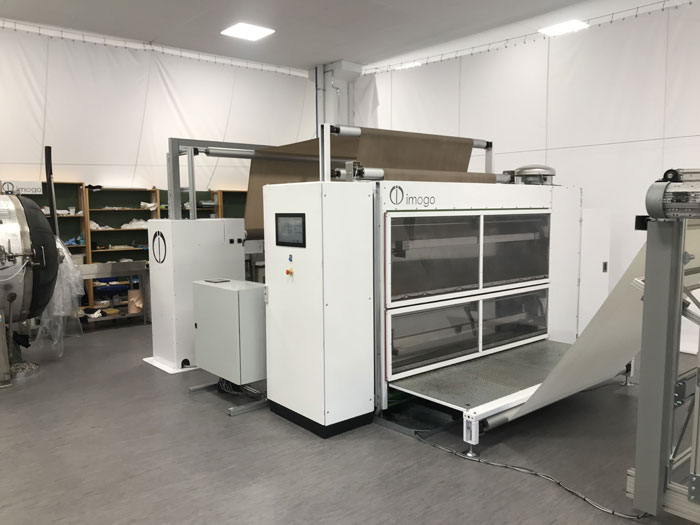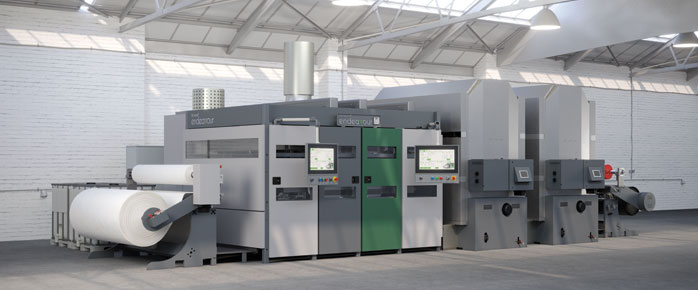
Textile Coloration’s Freshest Thinking On Saving Water
Article By Andrew Filarowski
The Society of Dyers and Colourists’ latest white paper includes insight from pioneering forces for the minimising of water use in dyeing processes. SDC Technical Director Andrew Filarowski, outlines current developments in this most urgent arena.
The global dyeing industry has always required vast quantities of water to facilitate coloration processes and, in general, still does – despite decades of efficiency improvements. Our sector’s toll on this most precious of the world’s resources is obvious – and obviously unsustainable – but, on a more positive note, no longer unavoidable.
Often quietly, in small projects, and under the international radar, collective efforts to devise and refine better ways of operating, are gathering pace. That dyeing does not have to involve many litres of water at each stage of processing, is not news, of course – but some of the bourgeoning, practical manifestations of this enlightened thinking is still surprisingly little known and taken-up.
Tentative ideas and incremental reductions in the need for so much H2O may seem like small developments but together they are becoming mighty – with the potential to disrupt the mainstream for the greater good.
I’m about to illustrate this bold claim with updates from a handful of forward-thinking companies, just some of the great work bubbling under. It would be easy for environmentalists – and who wouldn’t class themselves as an environmentalist in 2022? – to say this is too little too late for our industry and our planet.
But we at the SDC are imploring all dyers to commit to environmental ambitions with vigour, seizing the technological advancements becoming available. Every positive action counts. Our white paper, detailed at the foot of this article, argues that there is no reason for the coloration portion of the supply chain to impact the environment in the way it does today. If this makes uncomfortable reading, it is supposed to. If it fills you with ideas and inspiration, even better.
The potential of spray dyeing and finishing
So what is the latest news from the most progressive of dyehouses and laboratories? Let’s start in Sweden with imogo, a start-up project working to commercialise the use of spray for the application of dye. Founded in 2018, imogo is pioneering technology using high-speed electric valves and precision nozzles to coat fabric with dye or finishing liquid at speeds of up to 50 metres per minute. This method of coloration requires less than one litre of water per kilogram of fabric compared with traditional dyeing which would require around 20 litres.
[caption id="attachment_24184" align="alignnone" width="700"] Commercialising the use of spray for the application of dye.[/caption]
Moreover, the colour for this application is easy to come by – it’s already on the market, available off the shelf, and the high-quality end appearances, too, are what customers are used to seeing.
While current systems can handle cotton and cellulosic fabrics, a version for polyester is under development. This precisely-controlled method does not just cut water usage but energy, chemicals and time, too. No dye bath means no risk of dilution or contamination – an additional benefit. Of course a commercial dyer’s challenge would be in the implementation of such a system to an existing production line, but imogo is confident that initial outlay is likely to be recouped quickly in savings.
Digital dyeing to eliminate the ‘wet process’
Another company forging ahead with advances in much drier dyeing is Alchemie in the UK, whose system of high-velocity jets, to apply colour without immersion in liquid, is now being trialled in factories for high street clothing brand H&M and others. The only water required for Alchemie’s digital dyeing technology is for flushing, during the changeover of colours. An infrared system dries the fabric after dyeing so that it emerges, ready for finishing.
[caption id="attachment_24185" align="alignnone" width="698"]
Commercialising the use of spray for the application of dye.[/caption]
Moreover, the colour for this application is easy to come by – it’s already on the market, available off the shelf, and the high-quality end appearances, too, are what customers are used to seeing.
While current systems can handle cotton and cellulosic fabrics, a version for polyester is under development. This precisely-controlled method does not just cut water usage but energy, chemicals and time, too. No dye bath means no risk of dilution or contamination – an additional benefit. Of course a commercial dyer’s challenge would be in the implementation of such a system to an existing production line, but imogo is confident that initial outlay is likely to be recouped quickly in savings.
Digital dyeing to eliminate the ‘wet process’
Another company forging ahead with advances in much drier dyeing is Alchemie in the UK, whose system of high-velocity jets, to apply colour without immersion in liquid, is now being trialled in factories for high street clothing brand H&M and others. The only water required for Alchemie’s digital dyeing technology is for flushing, during the changeover of colours. An infrared system dries the fabric after dyeing so that it emerges, ready for finishing.
[caption id="attachment_24185" align="alignnone" width="698"] Alchemie Endeavour significantly reduces the carbon impact of dyeing.[/caption]
Alchemie’s Endeavour machine is available for polyester and cotton. It is calculated to reduce the carbon impact of dyeing a single polyester shirt from 1kg to 0.15kg, a saving of 85%. On the topic of bringing this system to an existing dyehouse, the company says one of its machines can replace up to five dye baths.
[caption id="attachment_24186" align="alignleft" width="400"]
Alchemie Endeavour significantly reduces the carbon impact of dyeing.[/caption]
Alchemie’s Endeavour machine is available for polyester and cotton. It is calculated to reduce the carbon impact of dyeing a single polyester shirt from 1kg to 0.15kg, a saving of 85%. On the topic of bringing this system to an existing dyehouse, the company says one of its machines can replace up to five dye baths.
[caption id="attachment_24186" align="alignleft" width="400"] Making traditional dyeing approaches more water efficient.[/caption]
The automated and optimised future of the dye bath
A third trailblazing company to be highlighted in this feature, Thies Group in Germany, has been supplying machinery that can make more traditional approaches much more water efficient. Then, exhaust dyeing processes deliver the highest quality results with regard to superior colour fastness, level dyeing, reproducibility, and an unlimited variety of colours – as well as flexible lot sizes between 1kg and 2000kg. Furthermore, they are not limited to particular articles, materials or make-up forms.
Sustainability is the driver for major innovation in design and control technology for dyeing machines and Thies Group – founded in 1892 – has recently been progressing the role of automaton.
The firm claims to enable a 73% reduction of water needed for pre-treatment, dyeing and after treatment, in comparison with volumes required 40 years ago. The company’s newest machine, the Signature Series will set even better benchmarks. Impressive savings – again, on chemicals, energy and time as well as water – are achieved by close attention to the whole process including pre and after-treatment. Digital measurement and analysis is enabling more water-efficient rinsing, washing and dye baths.
Adaptive Control supports automation across different machine brands
Thies Group is not the only pioneer in the field of automaton. Another company currently in the spotlight is Adaptive Control in the UK, whose non-proprietary PC-based and android automation solutions are allowing customers to fine-tune operations between different brands of machinery.
The firm cites one large UK customer saving 20% on volume of water across all processes thanks to savvy monitoring of usage and optimisation of rinsing processes. Reduction in water usage in these examples and others also leads to a downturn in amounts of effluent discharge necessary for production, and therefore further environmental and cost benefit.
[caption id="attachment_24187" align="alignnone" width="700"]
Making traditional dyeing approaches more water efficient.[/caption]
The automated and optimised future of the dye bath
A third trailblazing company to be highlighted in this feature, Thies Group in Germany, has been supplying machinery that can make more traditional approaches much more water efficient. Then, exhaust dyeing processes deliver the highest quality results with regard to superior colour fastness, level dyeing, reproducibility, and an unlimited variety of colours – as well as flexible lot sizes between 1kg and 2000kg. Furthermore, they are not limited to particular articles, materials or make-up forms.
Sustainability is the driver for major innovation in design and control technology for dyeing machines and Thies Group – founded in 1892 – has recently been progressing the role of automaton.
The firm claims to enable a 73% reduction of water needed for pre-treatment, dyeing and after treatment, in comparison with volumes required 40 years ago. The company’s newest machine, the Signature Series will set even better benchmarks. Impressive savings – again, on chemicals, energy and time as well as water – are achieved by close attention to the whole process including pre and after-treatment. Digital measurement and analysis is enabling more water-efficient rinsing, washing and dye baths.
Adaptive Control supports automation across different machine brands
Thies Group is not the only pioneer in the field of automaton. Another company currently in the spotlight is Adaptive Control in the UK, whose non-proprietary PC-based and android automation solutions are allowing customers to fine-tune operations between different brands of machinery.
The firm cites one large UK customer saving 20% on volume of water across all processes thanks to savvy monitoring of usage and optimisation of rinsing processes. Reduction in water usage in these examples and others also leads to a downturn in amounts of effluent discharge necessary for production, and therefore further environmental and cost benefit.
[caption id="attachment_24187" align="alignnone" width="700"] Adaptive Control supports automation across different machine brands[/caption]
To sum up, some of these advancements are still in development, and seeing only tentative and limited use so far. Others are already becoming more widely implemented in the mainstream. And our list is not intended to be exhaustive – merely illustrative of the sorts of water-conserving technology and innovation that’s increasingly out there to harness. The options for action are myriad, and will defend on dyers’ unique situations.
The SDC continues to support such great work with technical colour education, up to degree level and beyond, for the pioneers of the future – and the brighter, cleaner days ahead for our sector.
You can find out more about saving water, and other environmental considerations in dyeing, in Destination low carbon: Global technology and innovation reducing the environmental footprint of textile coloration, free to download from the SDC website now.
Adaptive Control supports automation across different machine brands[/caption]
To sum up, some of these advancements are still in development, and seeing only tentative and limited use so far. Others are already becoming more widely implemented in the mainstream. And our list is not intended to be exhaustive – merely illustrative of the sorts of water-conserving technology and innovation that’s increasingly out there to harness. The options for action are myriad, and will defend on dyers’ unique situations.
The SDC continues to support such great work with technical colour education, up to degree level and beyond, for the pioneers of the future – and the brighter, cleaner days ahead for our sector.
You can find out more about saving water, and other environmental considerations in dyeing, in Destination low carbon: Global technology and innovation reducing the environmental footprint of textile coloration, free to download from the SDC website now.

Textile Excellence
If you wish to Subscribe to Textile Excellence Print Edition, kindly fill in the below form and we shall get back to you with details.












